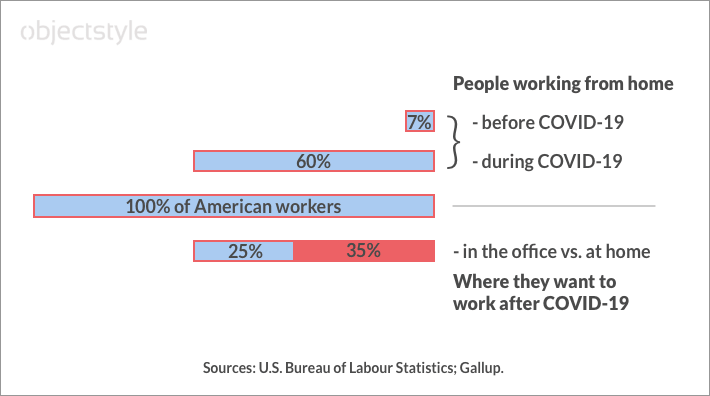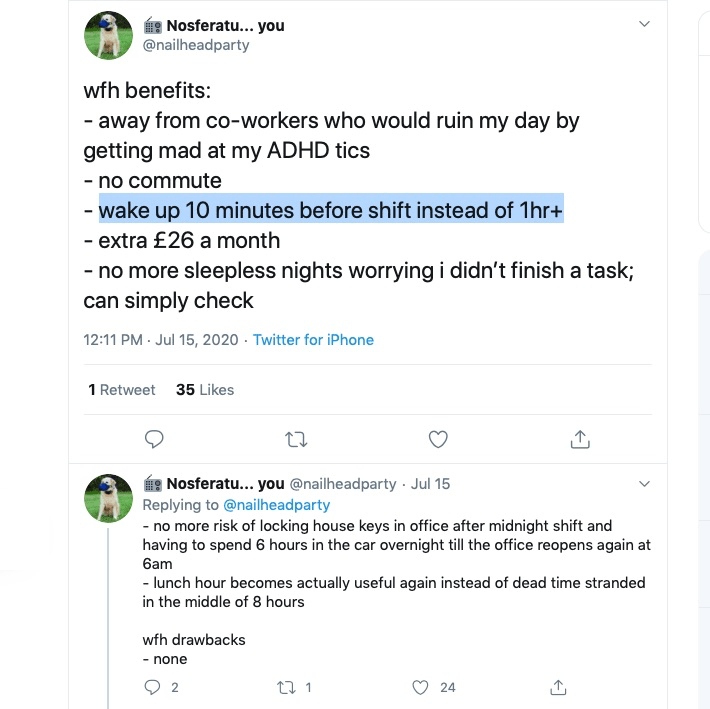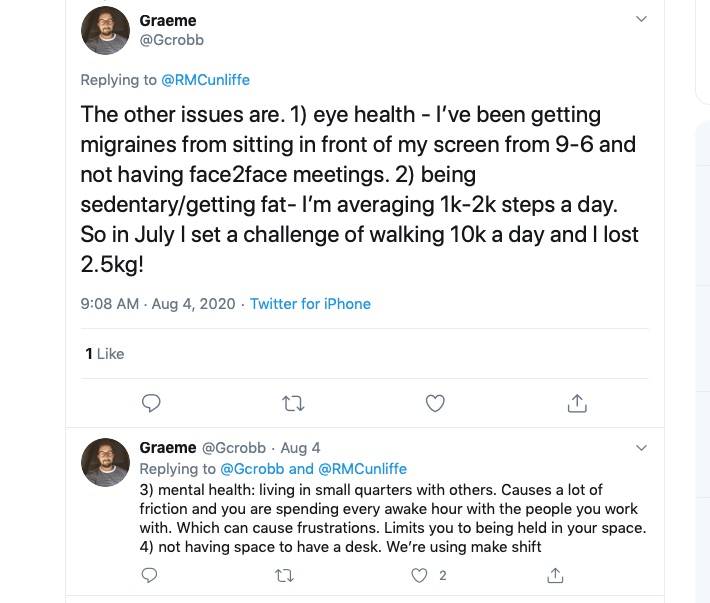35% of Americans don’t want to return to the office after the lockdown – here are their reasons

In recent years, there has been a lot of talk about remote work being the future of work. But it seemed to be limited to specific industries, like web design, and mindsets, like introverted people who care little about office snacks and social life.
The coronavirus pandemic has changed that.
Before the crisis, only 7% of Americans worked from home on a regular basis. With social distancing measures in place, that number rose to over 60%.
A recent survey by Gallup shows that, out of those people who have been working from home, 59% would like to remain remote workers after the pandemic. That’s 35% of the entire U.S. workforce.

Many companies, especially those in the tech sector, jumped in and officially allowed employees to work from home at least until the perceived end of the pandemic.
Microsoft updates WFH policy, lets employees work remotely through October https://t.co/0UWsZjvYAb
— Taylor Soper (@Taylor_Soper) May 6, 2020
Twitter employees can work from home "forever" if they want https://t.co/8nCkWghmnA
— Bloomberg Technology (@technology) May 16, 2020
Google employees will work from home until at least summer 2021.
The tech giant is the first major U.S. corporation to extend its work-from-home timeline so far into the next year. https://t.co/gZ9d8QgYez
— The Washington Post (@washingtonpost) July 27, 2020
Facebook employees to work from home until July 2021 due to coronavirus outbreak; get $1,000 for home offices https://t.co/8g5Gd9aOrp pic.twitter.com/Dzln5tIBJl
— Reuters (@Reuters) August 7, 2020
In addition, Facebook spokeswoman Pamela Austin said, “We found that we can sustain productivity to a very high degree with people working from home.
Salesforce will let its employees work from home at least until August 2021, with 6 extra weeks of time off for parents. https://t.co/XxkDeiWuIp
— Marc Benioff (@Benioff) August 22, 2020
Why continue to work from home?
Even some who never wanted to experiment with remote work were forced to do so because of COVID-19. And now many people have been drawing their conclusions. The most frequently-mentioned remote work benefits are:
- No need to commute to work (some people are saving two to four hours a day).
- Less money spent on clothes and personal care items.
- Less money spent on eating out.
- More time for hobbies.
- More quality time with family and friends.

Surprisingly nice things about the lockdown?
– More time with family
– Treasure little things e.g morning walk/coffee– Less driving = good for environment
– Oh, our single biggest household expense aka childcare = £0 = more money to invest while market’s down? 🤷🏿♂️
You? Go!
— Abraham Okusanya (@AbrahamOnMoney) March 25, 2020
What are the products you have purchased significantly less because of lockdowns? Mine are deodorant and hair products 😂
— Aaron Friedman🟦 (@AaronFriedman) August 20, 2020
The critique
This post would be incomplete if we didn’t mention that not everyone is happy with their newly acquired remote-work lifestyle. For various reasons, some people find it hard to work from where they live.
Reason number one is that many people don’t have the necessary conditions for remote work. Metropolitan area residents tend to live in small, cramped environments, often with roommates. Others might have kids at home who will bug them for attention whenever they are physically present.
This from a press release on new LSE research into young people in house-shares during lockdown. Anyone talking about how "working from home is here to stay" needs to factor this in. 9.3 square metres of personal space – to live and work in, 20+ hours a day pic.twitter.com/EWEG1UXg5F
— Rachel Cunliffe (@RMCunliffe) August 3, 2020
Plus, there are other nuances, such as having to hold online calls instead of face-to-face meetings, which takes a toll on one’s eyesight. Besides, not everyone has a proper desk and chair, which often leads to neck pains and back problems.

Remote work doesn’t equal “working from home”
I believe it should be mentioned that remote work does not necessarily mean working from home! Many were forced to start working from home because of COVID-19, which demonstrated that the quality of remote work is not lower – and often even higher – than the quality of the work produced at the office.
So some companies have had an “Aha” moment and are now more likely to hire remote employees. Therefore, a remote worker could be doing their job from a co-working hub or an offshore office in another city or country – not necessarily from home.
Due to COVID-19, 62% of hiring managers say their workforce will be more remote going forward. Find out more in the #FutureWorkforce Report: https://t.co/8k62JlZSo0 pic.twitter.com/KeHHnKVXlC
— Upwork (@Upwork) June 25, 2020
That said, if you are the kind of company that understands that talent can come from anywhere in the world, why not partner with ObjectStyle – an IT services provider with a track record for delivering outstanding work to clients!
TL; DR
The majority of those now working remotely in the U.S. (59%) say they are unwilling to go back to their office routine when the restrictions are lifted. At the same time, there are those (41%) who can’t wait to get out of their home offices. And an unintended consequence is that many companies now realize that remote employees can be just as effective as co-located ones. So they are now more open to hiring remote workers.
Related Blogs

25 best tools for distributed teams
LEARN MORE